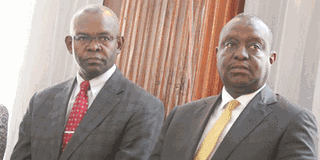Civil servants gobbled up Sh322 billion in allowances

Former National Treasury Cabinet Secretary Henry Rotich (right) and former Treasury PS Kamau Thugge drew Sh3.7 million in allowances each. FILE PHOTO | NATION MEDIA GROUP
What you need to know:
A summary of all employees across job groups showed that on average, 65 to 85 per cent of their take-home was in allowances.
This means some of the best-paid civil servants take home nearly five times their basic pay in allowances.
As public coffers run on empty, civil servants took home a staggering Sh322.5 billion in allowances last year.
A technical paper on streamlining allowances in the public sector seen by the Nation shows that the bulk of these billions was paid to employees who sit in air-conditioned offices as opposed to staff on the front-line of offering public services.
EXPLOSIVE
“While the majority (about 70 per cent) of civil servants work as teachers and nurses in front-line service delivery activities, the bulk of allowances (70 per cent) accrues to the 30 per cent of civil servants working in central government,” the paper notes. For a government that is mired debt, streamlining the wage bill is, according to the Salaries and Remuneration Commission (SRC), the best way to free up resources.
But it is not just the amounts that worry the SRC, but the explosive growth in the number of allowances too — from 31 in 1999 to 247 in 2019 — and the fact that public servants are earning them for doing essentially what they are paid a salary to do.
SUPERVISING
“Some allowances, for example taskforce and retreat allowances, are paid to compensate staff for responsibilities that are inherent in their jobs and therefore constitute double compensation,” the paper states. For instance, for supervising the budget-making process last year, former Treasury Cabinet Secretary Henry Rotich and his Principal Secretary Kamau Thugge drew Sh3.7 million in allowances each. Other officials that were involved in the process, a task they are employed to do in the first place, also claimed more than Sh2 million. Overall, the top allowances are house allowance (Sh64.9 billion), commuter allowance (Sh29.8 billion), local daily subsistence allowance (Sh17 billion) and hardship allowance (Sh13.3 billion). Others are police or prison allowance (Sh8.6 billion), facilitative allowance (Sh7.9 billion), foreign subsistence allowance (Sh5.8 billion) and mileage (Sh5.3 billion).
PROFESSIONALS
The paper also notes that allowances are often used to circumvent controls on the base pay.
“The practice has created inequity and unfairness within and across public service organisations, and has been a basis for requests for parity of treatment among cadres performing similar jobs under similar circumstances, the paper states. SRC also raises concern over allowances are still paid despite change in circumstances.
“For example, non-practice allowance paid to legal and health personnel was introduced to enhance salaries to facilitate attraction of professionals in the cadres from the private sector to address shortage in the public service,” the SRC document says. “The challenge is that some of the professionals are paid non-practice allowance and yet they are still practising and there is no shortage of the cadre and therefore attraction ceases to be a justification.”
FIVE TIMES
In one job group studied by the Nation, a cadre whose average basic pay was Sh32,367 ended up with a gross salary of Sh158,487 after allowances, meaning employees earned Sh126,120, or 80 per cent of their total monthly pay in allowances. A summary of all employees across job groups showed that on average, 65 to 85 per cent of their take-home was in allowances. This means some of the best-paid civil servants take home nearly five times their basic pay in allowances.





